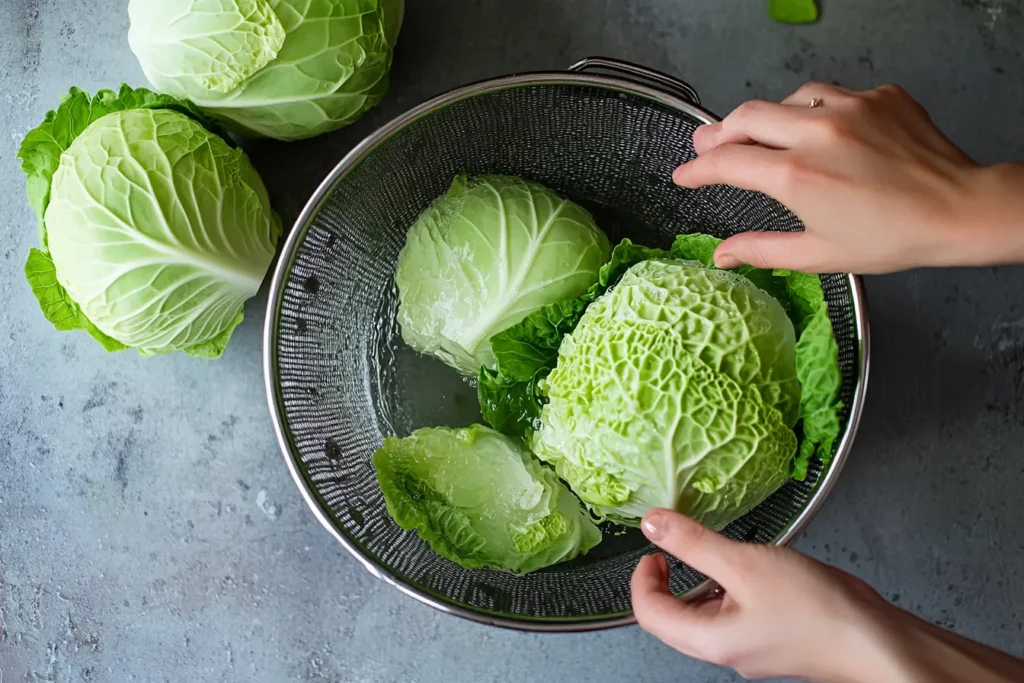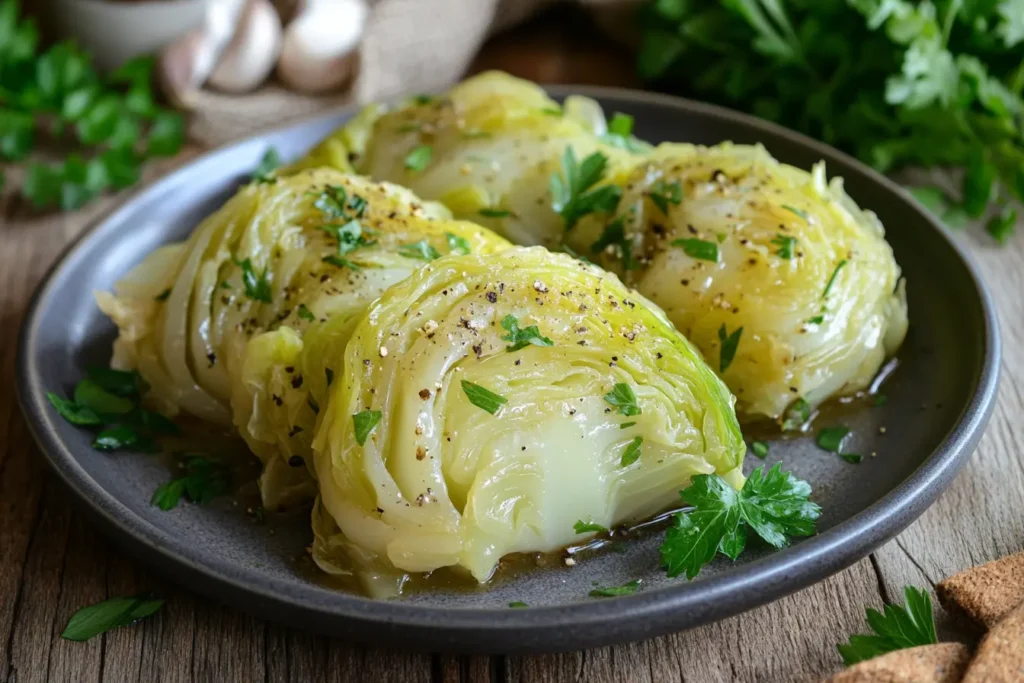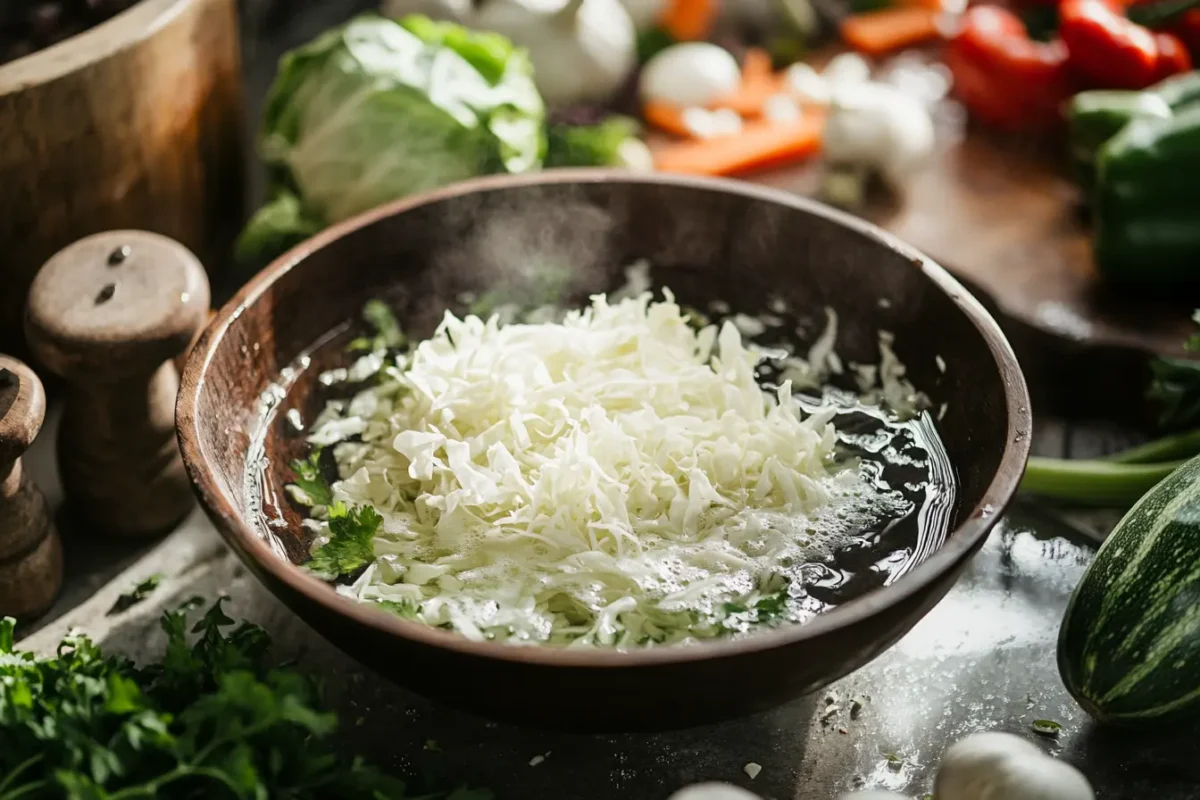Cabbage has been a staple in kitchens worldwide, celebrated for its versatility and nutrient-packed leaves. But did you know that soaking cabbage before cooking can elevate its taste and texture while ensuring it’s safe to eat? This article dives deep into the why and how of soaking cabbage, exploring everything from its culinary benefits to its cleaning properties.
Introduction to Soaking Cabbage
The Historical and Culinary Context
Cabbage is a versatile vegetable, but have you ever wondered, Why do you soak cabbage before cooking? This essential step can dramatically enhance the texture and flavor of your dishes while ensuring your cabbage is thoroughly clean. Whether you’re preparing a salad, stir-fry, or soup, soaking cabbage plays a critical role in its preparation.
Soaking cabbage, whether in plain water or salt water, serves several purposes. It tenderizes the leaves, balances flavors, and even extends its shelf life. Historically, this method was used to prepare cabbage for fermentation or preserve it for long winters. Over time, it’s become a must-do step for countless recipes.
Overview of Benefits
You might wonder, What’s the big deal with soaking cabbage? Well, it’s more than just tradition. Soaking can soften tough leaves, remove dirt and pesticides, and even help reduce the strong odor associated with cooked cabbage. Plus, for those looking to improve its flavor profile, soaking helps balance the natural bitterness.
When you soak cabbage, you’re not just cleaning it—you’re setting the stage for a better culinary experience. It’s a simple step with profound effects on taste, texture, and quality. As we explore this practice further, you’ll see why soaking cabbage is worth the extra effort.
The Science Behind Soaking Cabbage
How Water Interacts with Cabbage
Many cooks wonder, Why do you soak cabbage before cooking? The science is simple—soaking cabbage removes bitter sulfur compounds and softens the leaves. To dive deeper into the chemistry of vegetables and their preparation, check out this article on food science.
Soaking also dilutes certain compounds in cabbage that can give it a bitter taste. These naturally occurring sulfur compounds dissolve partially in water, leading to a milder flavor. It’s like giving your cabbage a mini makeover!
By removing dirt and debris trapped between the layers, soaking also ensures you’re not inadvertently adding grit to your meal. This step is especially useful if you’re working with organic or homegrown cabbage, where washing alone might not cut it.
Impact on Nutritional Content
You might think soaking cabbage could wash away its nutrients, but don’t worry—most of the essential vitamins and minerals remain intact. The process mainly affects water-soluble vitamins like vitamin C, but the loss is minimal, especially if you don’t soak it for too long.
Interestingly, soaking cabbage can sometimes enhance its health benefits. For example, the soaking process activates enzymes in raw cabbage that aid in detoxification and digestion. If you’re curious about how this ties into various recipes, check out this Cabbage and Sausage Recipe for ideas.
Methods of Soaking Cabbage
Using Plain Water vs. Salt Water
When it comes to soaking cabbage, the method you choose can make all the difference. Plain water works well for cleaning and softening the leaves, but if you want to go a step further, salt water is your secret weapon. A quick soak in salt water not only draws out impurities but also helps maintain the cabbage’s crisp texture.
Salt water soaking is particularly effective for dishes where texture matters, like slaws or stir-fries. The salt creates an osmotic effect, pulling out excess moisture while keeping the leaves firm. It also neutralizes some of the strong cabbage odor that can dominate your kitchen during cooking.
Duration and Temperature Considerations
How long should you soak cabbage? The answer depends on your goal. For a quick rinse, a 10-minute soak in cold water is enough. If you’re prepping for fermentation or want to reduce bitterness, a 20–30-minute soak in salted water will do the trick. Always use cold or room-temperature water, as hot water might make the leaves too soft or alter their flavor.
Pro tip: Be sure to drain and pat the leaves dry before cooking, especially for recipes that require frying or sautéing. Excess water can lead to steaming instead of browning, which might not give you the texture you’re aiming for.
If you’re looking for pairing ideas for your perfectly soaked cabbage, explore this side dish recipe for kielbasa and cabbage to round out your meal.
Culinary Advantages of Soaking Cabbage
Improving Texture and Flavor
Soaking cabbage before cooking isn’t just about cleaning—it’s a game-changer for texture and flavor. A quick soak softens the leaves, making them easier to work with when rolling or layering. For instance, recipes like stuffed cabbage rolls benefit immensely from this process, as pliable leaves are far easier to handle without tearing.
But there’s more! Soaking enhances the flavor by balancing the cabbage’s natural bitterness. The water works its magic by leaching out sulfur compounds, leaving behind a sweeter, milder taste. This is especially beneficial for dishes like coleslaw or stir-fries, where raw or lightly cooked cabbage is the star.
Reducing Bitterness and Enhancing Taste
One of the main reasons many cooks ask, Why do you soak cabbage before cooking? is to combat the sharp, bitter notes that can overpower dishes. This bitterness comes from glucosinolates, which dissolve partially during the soaking process.
Salt water soaking is particularly effective here. The salt draws out moisture along with these bitter compounds, making the cabbage taste more balanced. For soups and stews, this step ensures the cabbage integrates seamlessly into the dish without overwhelming the other flavors.
If you love pairing cabbage with bold flavors, try incorporating it into this Cabbage and Sausage Recipe. The soaking step will elevate the dish’s overall taste.
Soaking for Cleaning and Removing Impurities

Eliminating Dirt and Pesticides
Cabbage often contains dirt and pesticide residues. Soaking is a key step to ensure thorough cleaning. To learn more about food safety and proper produce cleaning techniques, visit the FDA’s official guidelines on cleaning produce.
If you’re using store-bought cabbage, this step is even more critical. Conventional produce may carry residues of pesticides or fertilizers that can cling to the leaves. Soaking ensures you’re starting with a clean slate, reducing any unwanted chemicals in your meal.
Preserving Freshness Before Cooking
Not only does soaking clean your cabbage, but it also refreshes it. If your cabbage has been sitting in the fridge for a while, soaking can reinvigorate its texture. The leaves rehydrate, becoming crisper and more vibrant. This simple step can make a world of difference, especially if you’re using the cabbage in fresh salads or slaws.
For more delicious recipe ideas that benefit from properly soaked cabbage, check out our collection of side dishes and mains on Peaceful Recipes. You’ll find plenty of inspiration to try out in your own kitchen!
Common Misconceptions About Soaking Cabbage
Does It Remove All Nutrients?
A common concern about soaking vegetables, including cabbage, is whether it leaches out all the nutrients. The truth is that soaking does result in a minor loss of water-soluble vitamins like vitamin C, but the impact is negligible. This small trade-off is far outweighed by the benefits of soaking, such as improved flavor, texture, and cleanliness.
It’s worth noting that the nutrients lost during soaking are minimal compared to the nutrients retained after cooking. Moreover, the cleaning process ensures you’re not consuming harmful residues, which could pose a greater risk than losing a fraction of vitamins. So, when people ask, Why do you soak cabbage before cooking?, the answer includes the assurance that you’re not compromising its overall nutritional value.
Is Soaking Always Necessary?
Although soaking cabbage has many benefits, it’s not always a must. For recipes where cabbage is thinly sliced and immediately cooked, a quick rinse may suffice. However, for dishes that require whole leaves or raw cabbage, soaking is highly recommended to ensure proper cleaning and optimal taste.
Skipping the soaking step might save time, but it could also lead to gritty textures or overpowering bitterness in your dish. For best results, assess the recipe’s needs and prepare the cabbage accordingly. Whether for soup, stew, or salad, soaking often ensures the final dish is clean and flavorful.
FAQs on Soaking Cabbage
Why Do You Soak Cabbage in Salt Water?
Soaking cabbage in salt water serves two main purposes: cleaning and enhancing flavor. Salt helps to draw out impurities, including dirt and tiny insects, while also reducing the cabbage’s natural bitterness. The result? A cleaner, tastier vegetable that’s ready for any dish.
How Long Should I Soak Cabbage Before Cooking?
The duration depends on your goal. For basic cleaning, a 10-minute soak in cold water works well. If you want to reduce bitterness or prepare cabbage for fermentation, extend the soak to 20–30 minutes. Always pat the cabbage dry afterward to avoid adding extra moisture to your recipe.
Does Soaking Cabbage Change Its Taste?
Absolutely! Soaking cabbage mellows its strong, sulfuric taste and enhances its natural sweetness. This is particularly noticeable in raw preparations like coleslaw or fresh salads, where a more balanced flavor is key.
Is Soaking Cabbage Better Than Rinsing?
For thorough cleaning and optimal flavor, soaking is better than rinsing. While rinsing removes surface dirt, soaking penetrates between the layers and helps eliminate hidden debris, bitterness, and excess odor. It’s a small step that makes a big difference in your final dish.
Additional Tips for Preparing Cabbage

Choosing the Right Type of Cabbage for Your Dish
Not all cabbages are created equal, and choosing the right type can make all the difference. Green cabbage is the most versatile and works well in soups, stews, and sautés. On the other hand, red cabbage is ideal for salads and slaws because of its vibrant color and slightly peppery taste. Savoy cabbage, with its crinkly leaves, is perfect for stuffed cabbage rolls, as the leaves are tender and easy to roll after soaking.
When preparing your chosen variety, keep in mind how soaking can enhance its qualities. For example, soaking green cabbage can soften its leaves for stir-fries, while soaking red cabbage can help balance its slightly bitter notes, making it sweeter and more enjoyable. So next time you wonder, Why do you soak cabbage before cooking?, remember that it’s also about maximizing the specific benefits of the variety you’re using.
Avoiding Over-Soaking and Over-Cooking
While soaking has its perks, over-soaking can be counterproductive. Leaving cabbage in water for too long can make it overly soft, affecting its texture. A 10–30-minute soak is usually sufficient depending on your needs. Likewise, over-cooking soaked cabbage can turn it mushy and diminish its flavor. Stick to quick cooking methods like sautéing, steaming, or lightly braising to retain its crispness and natural sweetness.
For a variety of recipes that balance soaking and cooking perfectly, explore options like stir-fries or soups featuring cabbage as a star ingredient.
Conclusion and Final Thoughts
Recap of Key Points
Soaking cabbage is a small but impactful step that can transform your cooking. From cleaning away dirt and pesticides to enhancing texture and flavor, this simple practice offers numerous benefits. Whether you’re preparing cabbage for a fresh salad, hearty stew, or flavorful stir-fry, soaking ensures your vegetable is clean, fresh, and ready to shine.
It’s not just about tradition or habit—it’s about achieving the best possible outcome for your dish. The answer to Why do you soak cabbage before cooking? lies in its ability to elevate your culinary experience by making your cabbage cleaner, tastier, and easier to work with.
Encouragement to Experiment in the Kitchen
Now that you understand the benefits of soaking cabbage, it’s time to experiment! Try using soaked cabbage in different recipes and notice how it improves taste and texture. Whether you’re crafting a vibrant coleslaw or a savory braised cabbage dish, this preparation step will make a noticeable difference. Soak, cook, and savor the results—your taste buds will thank you.
For more creative ideas, check out our other recipes and discover the endless possibilities with this humble yet versatile vegetable. Happy cooking!

